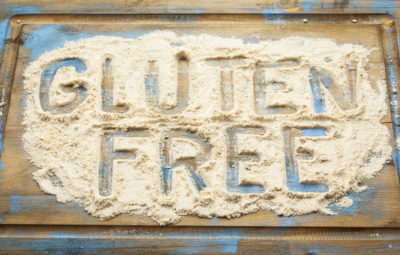Gluten Allergies And Sensitivities

Gluten is a protein found in wheat, barley, rye, and certain other grains. For some people, consuming foods containing gluten results in damage to the small intestine. This damage to the lining of the small intestine impairs their ability to properly absorb nutrients and if left untreated can lead to malnutrition and damage to other organs. On the Candida diet, gluten is avoided because of the inflammation that it can cause in the gut.
For people with a gluten intolerance, the ingestion of gluten produces an adverse reaction, often pain or abdominal discomfort, but not an immune response. Serious gluten intolerance is referred to as celiac disease. Celiac disease is also known as gluten-sensitive enteropathy, celiac sprue, and nontropical sprue. Although celiac disease is commonly referred to as a gluten allergy, it is not a true food allergy but rather an autoimmune disease.
In patients with celiac disease, ingesting gluten triggers an immune reaction that damages the small intestine. Food allergies trigger the creation of immunoglobulin E antibodies (IgE antibodies), while celiac disease triggers the creation of different antibodies, such as immunoglobulin A (IgA antibodies) and anti-tissue transglutimase (tTGA). With a food allergy, the body attacks the allergen (the food that triggers the allergic response) itself, while with celiac disease, the body attacks itself. Anti-histamines do not relieve the symptoms of celiac disease. Celiac disease is a life-long condition that has no cure. The treatment of celiac disease is a completely gluten-free diet.
- Celiac Disease
- Celiac Disease Information
- Living with CD
- Gluten Allergy for Kids
- Gluten Allergy
- Pediatric Celiac Disease
- Frequently Asked Questions about Celiac Disease
- Symptoms and Diagnosis of Celiac Disease
Symptoms of a Gluten Allergy
Symptoms of a gluten allergy differ in adults and children. In children, the symptoms appear after gluten is introduced into the diet, typically between four and eight months of age. In children, symptoms include: abdominal pain, discomfort, or cramping; distended or swollen abdomen; loose and watery stools; pale, bulky, foul-smelling stools; constipation; failure to gain weight; weight loss; irritability and behavior problems; vomiting; diarrhea; and dermatitis herpetiformis. Symptoms in adults include: diarrhea; constipation; foul-smelling stools; weight loss; abdominal bloating; excessive gas; heartburn or acid reflux; frequent indigestion; fatigue; anemia; depression; mouth ulcers; and dermatitis herpetiformis. Not everyone will have all these symptoms. For many people, symptoms do not occur immediately after eating a food containing gluten.
- Celiac Symptoms Checklist
- Celiac Disease Symptoms
- Gluten Intolerance and Celiac Disease Symptoms
- Celiac Symptoms and Tests
- Celiac Symptoms in Children
- Celiac Symptoms and Treatment
- Symptoms and Facts about Celiac Disease
- Celiac Symptoms and Related Diseases
Foods to Avoid
People that suffer from celiac disease, a gluten allergy, or a chronic Candida overgrowth must avoid all foods that contain gluten. Grains that contain gluten and should be avoided are: wheat, barley, rye, triticale, bulgar, couscous, durum, einkorn, emmer, farina, farro, kamut, semolina, and spelt or dinkel. Many people with celiac disease can eat oats (provided they have not been processed on machinery that processes gluten-containing grains or otherwise have been cross-contaminated with gluten), but a small number cannot. Items made from or containing these ingredients must be avoided. Examples include: barley malt, malt extract, malt syrup, malt vinegar, soya sauce made from wheat, modified food starch made from wheat, beer, and brewer’s yeast. Many pre-packaged and manufactured food items contain gluten. Carefully read the label of any packaged product for the ingredients listed above.


